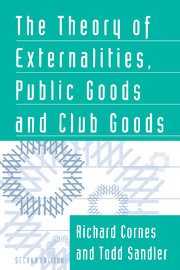Book contents
- Frontmatter
- Contents
- List of tables and figures
- Preface
- Part I Introduction to the theory of externalities, public goods, and club goods
- Part II Externalities
- Part III Public goods
- 6 Pure public goods: Nash-Cournot equilibria and Pareto optimality
- 7 Alternative mechanisms for provision of public goods
- 8 Public goods in general
- 9 Game theory and public goods
- 10 Departures from Nash-Cournot behavior
- Part IV Clubs and club goods
- Part V Applications and future directions
- References
- Author index
- Subject index
7 - Alternative mechanisms for provision of public goods
Published online by Cambridge University Press: 05 June 2012
- Frontmatter
- Contents
- List of tables and figures
- Preface
- Part I Introduction to the theory of externalities, public goods, and club goods
- Part II Externalities
- Part III Public goods
- 6 Pure public goods: Nash-Cournot equilibria and Pareto optimality
- 7 Alternative mechanisms for provision of public goods
- 8 Public goods in general
- 9 Game theory and public goods
- 10 Departures from Nash-Cournot behavior
- Part IV Clubs and club goods
- Part V Applications and future directions
- References
- Author index
- Subject index
Summary
The systematic tendency toward underprovision of a public good that seems to be implied by the model of Nash-Cournot equilibrium has encouraged extensive analysis of alternative allocative mechanisms and their evaluation against the yardstick provided by the set of Pareto-efficient allocations. The aim of this chapter, which is necessarily highly selective, is to review some of this large and varied literature. We begin with a closer look at the set of Pareto-efficient, or Paretooptimal, allocations.
Pareto-optimal provision of public goods
In the public goods economy, just as in its private goods counterpart, the optimality criterion typically identifies not one, but an infinite number of allocations – all the points on the utility possibilities frontier between R and S in Figure 7.1. Any discussion of “the optimum” must presuppose either a very special structure, so that there is, indeed, a single optimal level of Q associated with every allocation along the frontier RS, or else the introduction of some kind of social welfare function that enables us to rank optima and pick out the optimum optimorum. Economists have, however, often expressed and relied upon the hope that certain allocation decisions can be made without reference to distributional considerations. In the present context, this is reflected in many treatments that refer to the optimal level of provision of a public good without any explicit assumption concerning the distribution of private goods and hence of utility.
- Type
- Chapter
- Information
- The Theory of Externalities, Public Goods, and Club Goods , pp. 198 - 239Publisher: Cambridge University PressPrint publication year: 1996



